Household Items
Perfectly Creamy Scalloped Potatoes: A Step-By-Step Guide to Delightful Comfort Food.
Imagine a dish that combines the warmth of comfort food with a luscious, creamy texture that melts in your mouth. A dish that tantalizes your taste buds with layers of perfectly seasoned potatoes, bathed in a velvety sauce and topped with a golden, cheesy crust. That’s the magic of scalloped potatoes. This beloved classic has been captivating hearts and palates for generations, and now it’s your turn to master the art of creating perfectly creamy scalloped potatoes.
Scalloped potatoes, a comfort food staple, offer a delightful combination of simplicity and indulgence. With each forkful, you’re treated to the comforting familiarity of potatoes and the luxurious richness of a creamy sauce. It’s a dish that brings people together, evoking memories of family gatherings, holiday feasts, and cozy Sunday suppers.
In this comprehensive step-by-step blog post, we will take you on a culinary journey to discover the secrets behind achieving scalloped potatoes that are nothing short of perfection. From selecting the ideal potatoes to mastering the creamy sauce and achieving the perfect balance of textures, we will cover every aspect necessary to create a dish that will leave everyone asking for seconds.
Whether you’re a seasoned home cook looking to perfect your technique or a culinary enthusiast ready to delve into the world of scalloped potatoes for the first time, this guide will equip you with the knowledge and confidence to create a masterpiece. So, roll up your sleeves, sharpen your knives, and let’s embark on a culinary adventure to create the most tantalizingly creamy scalloped potatoes you’ve ever tasted.
Throughout this post, we will explore the nuances of scalloped potatoes, understand the importance of choosing the right ingredients, uncover the techniques that ensure creaminess, and even troubleshoot common pitfalls. So, get ready to elevate your cooking skills and become a master of this timeless and irresistible comfort food dish. Your taste buds are in for a treat as we unravel the secrets to achieving perfectly creamy scalloped potatoes that will have your family and friends coming back for more.
Unraveling the Essence of Scalloped Potatoes: A Deeper Dive into the Layers of Flavor and Texture.
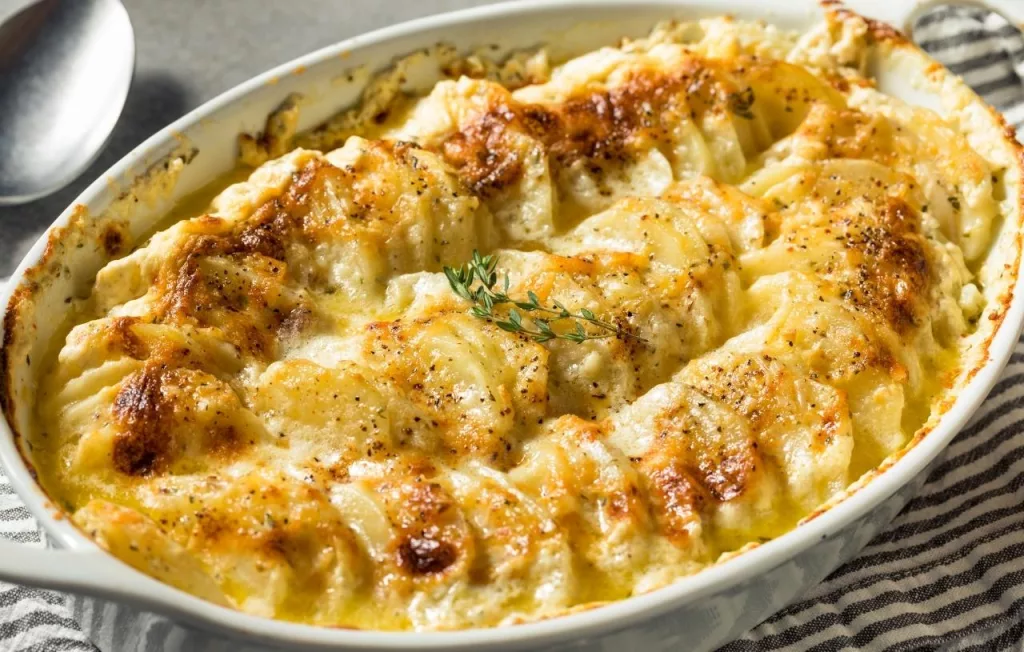
Understanding Scalloped Potatoes.
In the world of comfort food, few dishes can rival the sheer delight of scalloped potatoes. Picture this: thinly sliced potatoes, nestled together in a harmonious symphony of flavors and textures, enveloped in a luxurious blanket of creamy sauce that transforms each bite into a heavenly experience. It’s a dish that transcends simplicity, transforming humble potatoes into a masterpiece of culinary artistry.
Scalloped potatoes, also known as potatoes au gratin, have a rich history dating back centuries. Their name is derived from the French word “escalope,” meaning “shell” or “shaped slice,” which perfectly captures the essence of this dish. When you delve into a serving of scalloped potatoes, you discover a world of intricate layers, where every slice of potato is carefully arranged and bathed in a velvety sauce that binds them together.
To truly appreciate the magic of scalloped potatoes, it’s important to unravel the layers of flavor and texture that make this dish so exceptional. At its core, scalloped potatoes are a harmonious marriage of simplicity and indulgence. The star of the show is the potato itself, a humble vegetable that possesses a remarkable ability to absorb flavors while maintaining its own distinct character.
The potatoes used in scalloped potatoes are often russet or Yukon Gold varieties. These starchy potatoes are ideal for achieving that delicate balance of tenderness and structure. Their natural creaminess when cooked adds depth to each bite, while their ability to hold their shape ensures a satisfying texture that holds up to the rich sauce.
Speaking of the sauce, it is the heart and soul of scalloped potatoes. A velvety concoction that brings all the elements together, the sauce is a symphony of cream, milk, and cheese. Whole milk provides a luscious base, while heavy cream adds a luxurious richness that makes every mouthful a delight. The addition of cheese, such as sharp cheddar or nutty Gruyere, creates a flavorful melody that intertwines with the potatoes, infusing each layer with a savory note.
But scalloped potatoes are not solely defined by their creamy interior. A crucial aspect of their allure lies in the contrasting textures that await with each bite. The top layer, kissed by the heat of the oven, develops a golden crust that adds a delightful crunch. Beneath that golden surface lies a tender and creamy interior, where the potatoes yield effortlessly to your fork. It’s a symphony of textures that dance together, creating a truly sensational dining experience.
As we delve further into this guide, we will explore the nuances of selecting the perfect potatoes, master the art of creating the velvety sauce, and uncover techniques to achieve the ideal balance of flavors and textures. Get ready to embark on a culinary adventure that will leave you with the knowledge and skills to create scalloped potatoes that are nothing short of extraordinary. With each layer carefully crafted, and every slice meticulously arranged, you’ll unlock the secrets to a dish that epitomizes comfort, indulgence, and pure culinary bliss.
From Humble Tubers to Culinary Excellence: Unlocking the Art of Preparing Scalloped Potatoes.
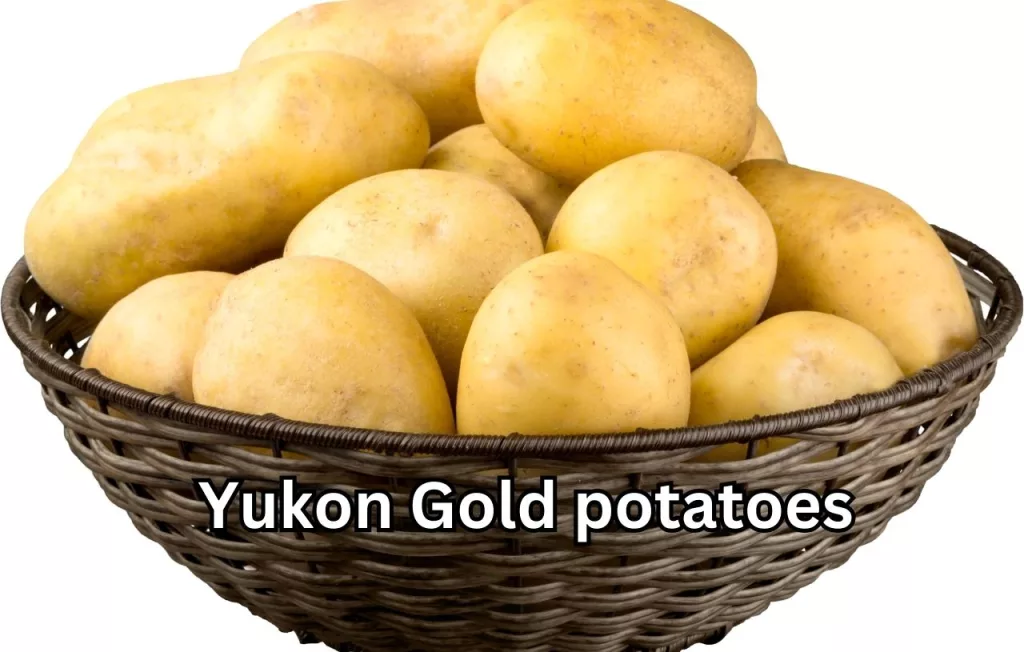
Preparing the Potatoes.
In the realm of scalloped potatoes, the journey to culinary excellence begins with the humble potato. These unassuming tubers hold within them the potential to transform into delicate, creamy slices that harmonize flawlessly with the layers of sauce. To embark on this gastronomic adventure, we must first explore the art of preparing the potatoes—the foundation upon which the entire dish is built.
The selection of the right potato variety is paramount. Russet and Yukon Gold potatoes reign supreme in the realm of scalloped potatoes, thanks to their unique characteristics. Russets, with their high starch content, offer a fluffy and delicate texture, while Yukon Golds, with their naturally buttery flavor, bring a subtle richness to the dish. Choosing either of these varieties ensures a gratifying outcome that perfectly complements the creamy sauce.
Now, imagine yourself holding a sharp knife, ready to unveil the potential within each potato. The art lies in achieving uniformity in thickness, allowing for even cooking and a harmonious blend of textures. A mandoline slicer can be an invaluable tool in this process, ensuring precise and consistent slices. However, if you prefer a more hands-on approach, a sharp knife and a steady hand will serve you well.
Begin by peeling the potatoes, unveiling their hidden allure, and revealing the pure canvas upon which flavors will unfold. Once peeled, the true artistry begins: the delicate task of slicing the potatoes into thin, even discs. Take your time, applying just the right amount of pressure to ensure uniformity. Each slice, resembling a miniature work of art, should be approximately 1/8 inch thick. This ensures that the potatoes cook evenly and harmoniously absorb the flavors of the creamy sauce.
But wait—there’s more to consider in this artistic endeavor. Some chefs prefer to rinse the potato slices to remove excess starch, while others embrace it, appreciating the starch’s ability to thicken the sauce as it bakes. It’s a matter of personal preference and experimenting with both methods will help you discover the perfect balance for your palate.
Now that you have prepared the potatoes, envision the culinary masterpiece that awaits. Each slice represents a stroke of genius, waiting to be layered and immersed in the creamy depths of the sauce. The uniformity of the slices ensures that every bite is a symphony of tenderness and flavor. With the potatoes prepared, the stage is set for the magic to unfold as we dive into the creation of the velvety sauce and the assembly of the layers.
Remember that the art of scalloped potatoes lies not only in the final masterpiece but also in the meticulous preparation of the potatoes themselves. Treat each slice with care, allowing them to become the building blocks of a dish that will captivate your senses. With each stroke of the knife, you’re one step closer to unlocking the true potential of scalloped potatoes—a culinary masterpiece that exemplifies the art of transforming humble ingredients into sheer excellence.
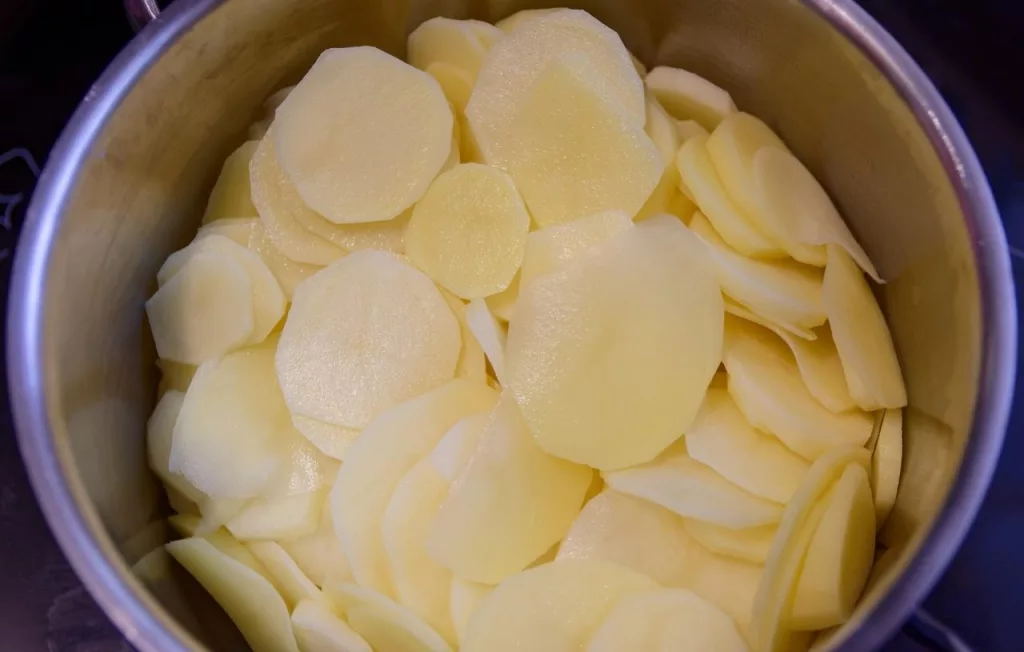
Unleashing the Creamy Delight: Elevating Scalloped Potatoes to New Heights of Decadence.
Enhancing the Creaminess
Picture a symphony of flavors dancing upon your palate—a harmonious blend of velvety textures and indulgent creaminess. That’s the essence of scalloped potatoes at its finest. To achieve this divine level of culinary bliss, we must delve into the art of enhancing the creaminess—the secret to elevating scalloped potatoes from a mere side dish to a tantalizing feast for the senses.
At the heart of the creaminess lies the silky sauce that coats each layer of potatoes, infusing them with richness and depth. It’s essential to select the right combination of dairy components to strike the perfect balance between lusciousness and flavor. Here, we unveil the secrets to creating a sauce that will transform your scalloped potatoes into a luxurious indulgence.
The base of the sauce begins with whole milk — a creamy canvas that serves as the foundation for a delectable masterpiece. The milk’s inherent richness lends a velvety smoothness to the dish, enveloping the potatoes in a blanket of comfort. As the sauce simmers, the milk mingles with the other ingredients, forming a delicate fusion of flavors.
To enhance the creaminess, we introduce the pièce de résistance: heavy cream. This opulent addition elevates the sauce to new heights, infusing it with a luxurious decadence that envelops each potato slice. The cream’s higher fat content brings a delightful richness, ensuring a truly indulgent experience with every bite. It transforms the dish from ordinary to extraordinary, indulging your taste buds with its velvety embrace.
But we’re not done yet. To elevate the flavor profile, we introduce the magic of cheese—the culinary alchemist that adds depth, complexity, and a touch of irresistible tang. Sharp cheddar, Gruyere, or Parmesan are popular choices, each lending their unique character to the sauce. As the cheese melts, it melds with the cream and milk, creating a symphony of flavors that intertwine with the tender potatoes, resulting in a harmonious medley of creamy delight.
For those who dare to venture beyond the traditional, we open the doors to a world of endless possibilities. Infusing the sauce with minced garlic lends a subtle hint of pungency, adding intrigue to each mouthful. Fresh herbs like thyme or rosemary introduce a symphony of fragrances, enhancing the aromatic bouquet that fills the kitchen. Spices such as nutmeg or paprika bestow a touch of warmth and complexity, teasing the taste buds with their subtle nuances.
The art of enhancing the creaminess lies not only in the selection of ingredients but also in the precise measurements and meticulous technique. The sauce should coat the back of a spoon, neither too thin nor too thick, ensuring a perfect harmony between the potatoes and the creamy embrace that surrounds them.
With each layer of sauce carefully drizzled and each potato slice immersed in the divine amalgamation, you’re one step closer to the pinnacle of creaminess. As the scalloped potatoes bake, the sauce melds with the tender spuds, transforming the dish into a masterpiece of textures and flavors.
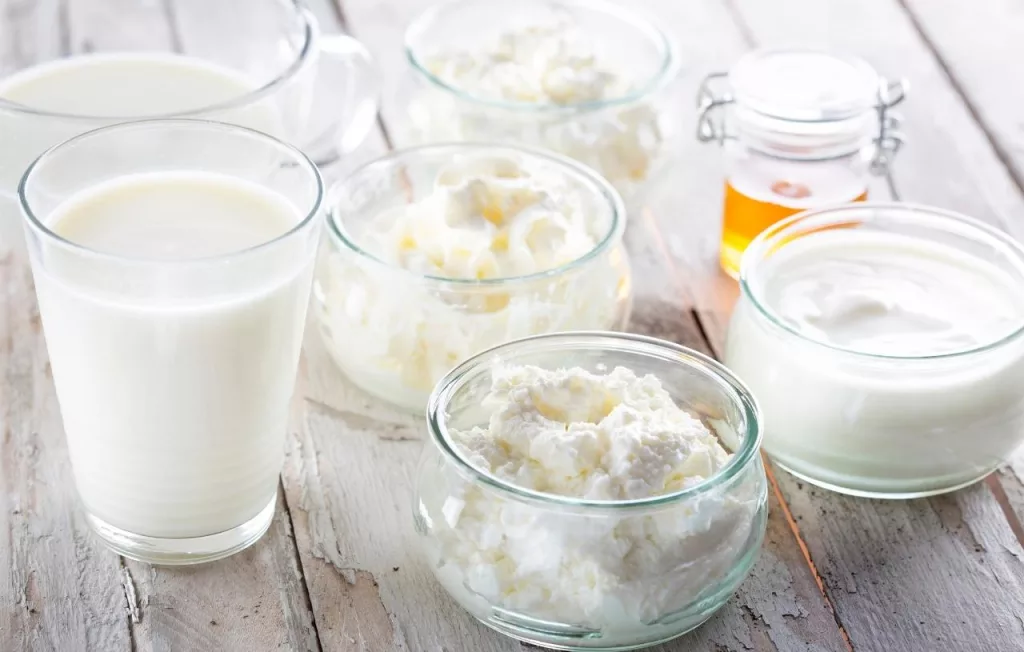
Building a Tower of Flavor: The Art of Layering and Baking Scalloped Potatoes.
Layering and Baking
Imagine a symphony of flavors and textures, meticulously arranged in a dish that promises to tantalize your taste buds. The art of layering and baking scalloped potatoes is where the true magic happens—the moment when each ingredient harmonizes to create a tower of flavor that will transport you to culinary bliss. In this section, we unveil the secrets to achieving the perfect layering technique and guide you through the baking process, ensuring that your scalloped potatoes emerge from the oven as a masterpiece.
To begin this culinary journey, you’ll need a baking dish—your canvas for creating a symphony of layers. Choose a dish that allows for even heat distribution and ample space to accommodate the potatoes and sauce. Grease the dish lightly to ensure easy removal and to prevent the potatoes from sticking.
Now, imagine the first layer — a foundation upon which the entire tower will rest. Begin by arranging a single layer of thinly sliced potatoes, meticulously overlapping each slice. Take care to create a tight and even layer, ensuring a consistent texture throughout. As you place each potato slice, visualize the delicate dance of flavors that awaits — the tenderness of the potatoes and the creamy embrace that will envelop them.
Once the first layer is complete, it’s time to introduce the star of the show—the creamy sauce. Drizzle a generous amount of the sauce over the potatoes, ensuring that every slice is lovingly coated. This is where the flavor infusion begins, as the sauce seeps into the crevices, transforming the potatoes into a medley of sumptuousness. Each layer is an opportunity to build upon the flavors, adding depth and complexity with each subsequent addition.
Continue the process, layer by layer, until the dish is filled with a tapestry of potatoes and sauce. As you build, take a moment to appreciate the beauty of the layers—the symphony of colors and textures that awaits. Ensure that each layer is as evenly distributed as possible, allowing the flavors to meld and the textures to harmonize.
As you are near the final layer, envision the crescendo of flavors that is yet to come. Finish with a flourish, drizzling a generous amount of sauce over the top—the pièce de résistance that will create a luscious blanket of creaminess. Sprinkle a layer of cheese atop the sauce, ready to melt and create a golden, irresistible crust.
Now, it’s time to seal the flavors and textures within the dish. Cover it with foil, creating a protective shield that allows the potatoes to cook to perfection. As the dish bakes in the oven, a magical alchemy occurs—the heat coaxing the flavors to blend, the sauce to thicken, and the cheese to melt and bubble. It’s a sensory symphony, filling the kitchen with an irresistible aroma that promises a culinary revelation.
As baking time nears completion, it’s time to unleash the final act of artistry. Remove the foil and allow the top layer to bask in the heat, transforming into a golden crust with a delightful crunch. The contrast of textures—a crispy top layer giving way to a velvety interior—creates a sensory experience that will have you yearning for more.
With the aroma filling the air and anticipation building, the moment of truth arrives. Carefully remove the dish from the oven, and behold your creation—a tower of flavors, each layer bursting with creamy delight. Allow the dish to rest for a few minutes, giving the flavors time to settle and meld.
Now, it’s time to serve your masterpiece. Spoon generous portions onto plates, revealing the intricate layers that await. Each forkful presents a symphony of flavors and textures—a delicate balance of creamy, tender potatoes, and the golden crust that crowns the dish.
The Texture Temptation: Mastering the Art of Scalloped Potatoes’ Perfect Balance.
Achieving the Perfect Texture
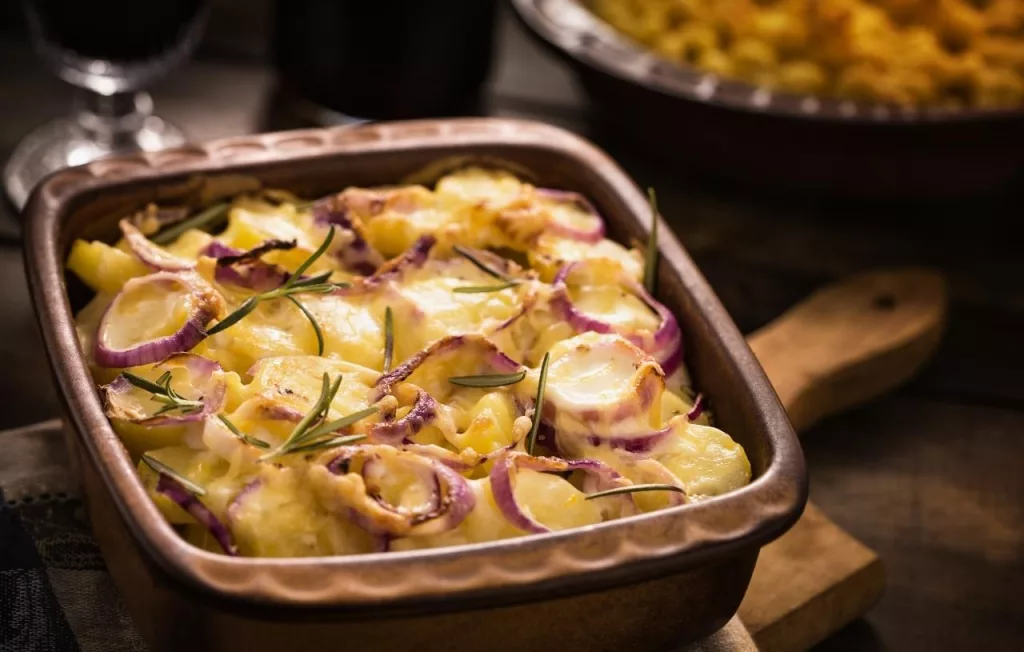
In the realm of culinary craftsmanship, achieving the perfect texture is an art form that separates the exceptional from the ordinary. When it comes to scalloped potatoes, the interplay between a crispy golden top and tender, melt-in-your-mouth potatoes creates an irresistible symphony for the senses. In this section, we delve into the techniques that will guide you towards the coveted perfect texture—an equilibrium that will have you savoring each bite with sheer delight.
As the scalloped potatoes bake, the heat gently transforms the dish, allowing it to reveal its true potential. Achieving the desired texture begins with understanding the variables at play—the baking time and temperature that govern the outcome. With precision and finesse, you can tailor these factors to suit your preferences and elevate your scalloped potatoes to new heights.
When it comes to the top layer, the goal is to achieve a delicate balance—a golden, crispy crust that provides a satisfying contrast to the velvety interior. To accomplish this, we employ a technique that involves adjusting the baking time and temperature. As the dish nears completion, carefully remove the foil covering and allow the top layer to bask in the heat, transforming it into a delectable crunchy crust. Keep a close eye on the dish during this crucial stage to prevent it from becoming overly browned or burnt. With patience and attention, you can achieve that sought-after balance of crispness and tenderness.
The level of tenderness in the potatoes is equally vital in achieving the perfect texture. Baking time plays a significant role here, as it determines the softness of the potato slices. A longer baking time will result in more tender potatoes, while a shorter time will yield slices with a bit more bite. Consider your personal preference and the overall texture you wish to achieve as you navigate the timing. Remember to check the potatoes’ doneness by gently inserting a fork into the dish—the potatoes should be tender, yet not mushy.
Additionally, the size and thickness of the potato slices will influence the cooking time required to reach the desired tenderness. Thinly sliced potatoes will cook faster, while thicker slices may require a bit more time in the oven. Consistency in the slicing technique ensures even cooking throughout the dish, resulting in a harmonious texture from the first layer to the last.
Should you desire a dish with a slightly firmer texture or a more tender outcome, don’t be afraid to experiment with the baking time and temperature. These variables allow you to tailor the dish to your preferences, whether you crave a potato with a bit more bite or one that melts seamlessly on your tongue. The beauty of scalloped potatoes lies in their versatility, accommodating a wide range of textures to suit your personal taste.
Culinary Companions: Elevating Scalloped Potatoes with Perfect Pairings and Presentation.
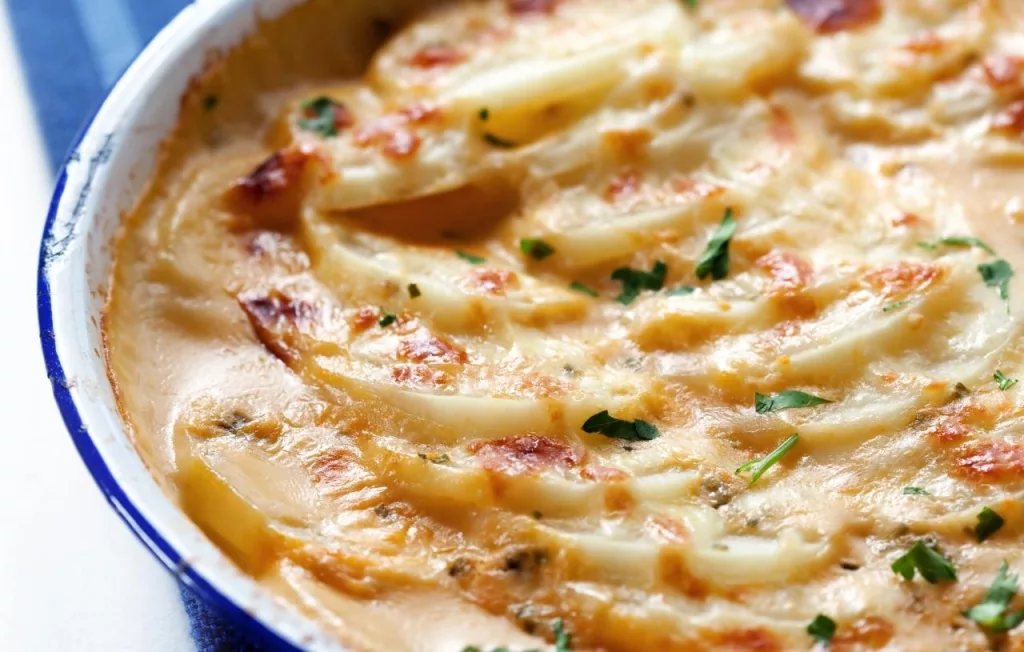
Serving and Pairing Suggestions
As you stand before a dish of perfectly crafted scalloped potatoes, a canvas of creamy delight awaits. But the experience doesn’t stop there. To truly elevate this culinary masterpiece, we must explore the art of serving and pairing—unveiling the possibilities that enhance the flavors, tantalize the senses, and create a symphony of satisfaction. In this section, we present a repertoire of serving suggestions and pairing options, ensuring that your scalloped potatoes are celebrated in all their glory.
First, let us adorn this culinary artwork with a touch of visual appeal. Consider garnishing the dish with a sprinkle of vibrant, fresh herbs—chopped chives, parsley, or a sprig of thyme. These delicate green accents not only add a pop of color but also infuse the dish with a hint of freshness, inviting your guests to partake in a feast for both the eyes and the palate.
Presentation is key. Serve the scalloped potatoes in an elegant, oven-to-table baking dish, allowing their captivating layers to take center stage. The artistry lies in the reveal—a moment when you lift the veil and showcase the intricate strata of potatoes, coated in a velvety sauce, and crowned with a golden crust. This dramatic unveiling will undoubtedly capture the attention and anticipation of your guests.
Now, let’s delve into the world of pairing—complementary flavors that enhance the scalloped potatoes and create a harmonious culinary experience. Consider the main course that will accompany this dish, allowing it to shine and creating a balanced ensemble of flavors on your plate.
Scalloped potatoes pair exceptionally well with roasted meats, offering a satisfying contrast of textures and flavors. Picture a perfectly seared steak or a succulent roast chicken, their juices mingling with the creamy sauce, creating a medley of savory bliss. The richness of the potatoes complements the hearty, umami notes of the meat, resulting in a symphony of flavors that will leave your taste buds in awe.
For a vegetarian or lighter option, consider serving scalloped potatoes alongside a crisp, refreshing salad. The fresh, vibrant greens and crunchy vegetables provide a delightful contrast to the creamy potatoes, offering a textural balance that elevates the overall experience. The lightness of the salad serves as a refreshing palate cleanser, enhancing each subsequent bite of the indulgent dish.
Roasted vegetables also make excellent companions for scalloped potatoes. The caramelization of the vegetables imparts a delightful sweetness, harmonizing with the creamy, savory notes of the dish. Imagine the earthy richness of roasted Brussels sprouts, the natural sweetness of caramelized carrots, or the smoky char of grilled asparagus—all playing their part in creating a symphony of flavors on your plate.
As you embark on this culinary journey, don’t be afraid to experiment and explore. Scalloped potatoes offer endless opportunities for personalization and adaptation to suit your preferences. Whether you choose to infuse the sauce with your favorite herbs or spices or venture into uncharted territory with unique pairing combinations, let your creativity be your guide.
Mastery Through Challenges: Troubleshooting Tips and Clever Techniques for Scalloped Potatoes.

Troubleshooting and Tips
Even the most skilled culinary artists encounter challenges along their gastronomic journey, and scalloped potatoes are no exception. Fear not, for in this section, we embrace the opportunity to refine our skills by addressing common pitfalls and offering clever techniques to overcome them. By delving into troubleshooting and sharing expert tips, we equip you with the knowledge and confidence to navigate any obstacle that may arise on your quest for scalloped potato perfection.
- Soggy Potato Woes: The dreaded specter of watery scalloped potatoes can be conquered. To prevent excess liquid, ensure you slice the potatoes evenly and layer them tightly in the baking dish. The closer the potato slices are packed, the less room there is for liquid to accumulate. Additionally, be cautious when adding the creamy sauce, as too much can result in a watery consistency. Exercise restraint and gradually pour the sauce over the layers, allowing it to seep into the potatoes without overwhelming them.
- The Pre-Baking Paradox: Some enthusiasts wonder whether it’s necessary to pre-bake the potato slices before layering them. While pre-baking can help achieve a firmer texture and reduce excess moisture, it is not essential. However, if you prefer a drier and more structured final dish, you can lightly parboil or bake the potato slices before layering them. This technique can also speed up the overall baking time.
- Texture Troubles: If you find your scalloped potatoes have an inconsistent texture, with some slices undercooked and others overdone, fear not—we have a solution. To ensure even cooking, aim for uniform thickness when slicing the potatoes. Thinner slices will cook more quickly, while thicker slices may require a longer baking time. By achieving uniformity, you set the stage for a harmonious texture throughout the dish.
- The Perfect Cheese Distribution: As the golden crust beckons, you may encounter the challenge of uneven cheese distribution. To ensure each bite boasts the melty goodness of cheese, sprinkle the cheese evenly over each layer of sauce. This ensures that every slice of potato is embraced by its cheesy touch. Consider using a combination of grated and shredded cheese for enhanced coverage and a varied texture.
- The Crispy Top Conundrum: If you find that your top layer isn’t as crispy as desired, fear not, for there is a simple technique to rectify this. During the last few minutes of baking, remove the foil covering to expose the top layer to direct heat. This allows the surface to brown and develop that irresistible golden crust. Keep a watchful eye, as the browning process can happen quickly. You want a perfect balance — a crispy top without sacrificing the tenderness of the potatoes beneath.
- Patience is a Virtue: Allow the scalloped potatoes to rest for a few minutes after baking before serving. This brief interlude allows the flavors to meld and the sauce to set, resulting in a more cohesive and delectable dish.
At this point, you should remember that challenges are mere opportunities for growth. Armed with these troubleshooting tips and clever techniques, you have the tools to conquer any obstacle that comes your way on your quest for scalloped potato mastery.
Embrace the challenges, learn from them, and celebrate the triumphs that await. With each hurdle overcome, your culinary prowess expands, and your scalloped potatoes ascend to new heights of excellence. So, fear not the roadblocks; rather, relish the chance to refine your skills and create scalloped potatoes that leave a lasting impression.
A Masterpiece on Your Plate: The Culinary Triumph of Perfectly Creamy Scalloped Potatoes.
Conclusion: Unleash Your Inner Culinary Artist
Congratulations! You have journeyed through the realms of flavor, texture, and presentation, mastering the art of crafting perfectly creamy scalloped potatoes. What started as a humble dish has transformed into a culinary masterpiece that will captivate palates and create lasting memories.
As you savor each decadent bite of your scalloped potatoes, you can take pride in the knowledge and skills you have acquired. The tender layers of potatoes, bathed in a velvety sauce and crowned with a golden crust, embody the perfect balance of flavors and textures—an achievement that only a true culinary artist can accomplish.
But this is just the beginning of your culinary adventure. Armed with the techniques and insights gained, you can continue to explore the boundless possibilities of scalloped potatoes. Infuse the sauce with your favorite herbs and spices, experiment with unique cheese combinations, or introduce unexpected ingredients to elevate this classic dish to new heights.
Share your newfound expertise with friends and family, inviting them to experience the joy of perfectly creamy scalloped potatoes. As you gather around the table, the aroma filling the air, their taste buds will be tantalized, and their hearts warmed by the comfort of this timeless comfort food.
Remember, culinary artistry is an ongoing journey, a perpetual quest for excellence. With each batch of scalloped potatoes, you refine your skills, honing your ability to create culinary delights that transcend the ordinary. So, embrace the creativity within you, continue to experiment, and let your imagination soar.
Frequently Asked Questions (FAQ) about Perfectly Creamy Scalloped Potatoes.

Q1: Can I make scalloped potatoes ahead of time?
A: Yes, you can prepare scalloped potatoes ahead of time. After assembling the dish, cover it tightly with foil or a lid, and refrigerate for up to 24 hours. When you’re ready to serve, bake the dish according to the recipe instructions. Keep in mind that the potatoes may take a little longer to cook if they were refrigerated, so adjust the baking time accordingly.
Q2: Can I freeze scalloped potatoes?
A: While it is possible to freeze scalloped potatoes, the texture may be affected. Potatoes tend to become grainy or mushy when frozen and thawed. If you plan to freeze scalloped potatoes, it’s best to do so before baking them. Assemble the dish, cover it well with foil or a freezer-safe container, and freeze for up to 2 months. When you’re ready to enjoy them, thaw the dish overnight in the refrigerator before baking it according to the recipe instructions.
Q3: How can I make scalloped potatoes dairy-free?
A: To make scalloped potatoes dairy-free, you can replace the dairy ingredients with suitable alternatives. Instead of milk and heavy cream, use non-dairy milk, such as almond milk or oat milk, combined with a dairy-free butter substitute. For the cheesy flavor, try using nutritional yeast or a dairy-free cheese alternative. Keep in mind that the taste and texture may differ slightly from the traditional version, but with some experimentation, you can create a delicious dairy-free alternative.
Q4: Can I use different types of cheese in scalloped potatoes?
A: Absolutely! Scalloped potatoes provide an excellent opportunity to experiment with different cheese combinations. While traditional recipes often call for sharp cheddar or Gruyere, you can explore a wide range of flavors by incorporating cheeses like Parmesan, Swiss, Fontina, or even a creamy blue cheese. Combining different cheeses can add depth and complexity to the dish, so feel free to let your creativity guide you.
Q5: What are some variations I can try with scalloped potatoes?
A: Scalloped potatoes are versatile and lend themselves well to variations. Here are a few ideas to inspire your culinary experiments:
- Add layers of caramelized onions or sautéed mushrooms between the potato slices for added depth of flavor.
- Incorporate cooked bacon or pancetta for a savory twist.
- Introduce different herbs and spices to the sauce, such as rosemary, thyme, or paprika, to customize the flavor profile.
- Experiment with vegetable additions like spinach, kale, or roasted red peppers to introduce extra colors and nutrients to the dish.
- Explore different types of potatoes, such as sweet potatoes or a mix of root vegetables, to create a unique and flavorful medley.
Q6: Can I use pre-sliced or frozen potatoes for scalloped potatoes?
A: While pre-sliced or frozen potatoes may be convenient, they tend to have a higher moisture content, which can affect the texture of the final dish. It is best to use fresh potatoes and slice them yourself for optimal results. This way, you have control over the thickness of the slices, ensuring even cooking and the desired texture.
Q7: Can I reheat leftover scalloped potatoes?
A: Leftover scalloped potatoes can be reheated. Place them in a baking dish, cover with foil, and heat in a preheated oven at around 350°F (175°C) until warmed through. Keep an eye on them to prevent overcooking or drying out. Alternatively, you can reheat individual portions in the microwave, using short bursts of heat to avoid uneven heating.
Q8: Are scalloped potatoes gluten-free?
A: The traditional recipe for scalloped potatoes is typically gluten-free as it does not contain ingredients with gluten. However, it’s essential to check the ingredients of any added seasonings, sauces, or pre-packaged cheese blends for potential gluten content. If you have specific dietary requirements, always read labels carefully or prepare homemade versions of these ingredients to ensure they are gluten-free.
Q9: Can I use a different type of potato in scalloped potatoes?
A: While russet and Yukon Gold potatoes are the most used varieties for scalloped potatoes, you can experiment with different types of potatoes. Waxy potatoes, like red potatoes or fingerling potatoes, will hold their shape better but may have a slightly different texture. Sweeter potatoes, such as sweet potatoes or yams, can be used for a unique twist on the classic dish. Keep in mind that different potato types may affect the overall taste, texture, and appearance of the final dish.
Q10: Can I add other vegetables to scalloped potatoes?
A: Absolutely! Scalloped potatoes serve as an excellent base for incorporating other vegetables into the dish. Sautéed or roasted vegetables like bell peppers, zucchini, or corn can add color, flavor, and extra nutrients. Just ensure that the additional vegetables are cooked or prepped beforehand to ensure they are tender when the scalloped potatoes finish baking.
Remember, scalloped potatoes are a canvas for your culinary creativity. Feel free to adapt the recipe to suit your taste preferences, dietary needs, and culinary experiments. With the knowledge gained from this guide and your own ingenuity, you’re well-equipped to embark on a scalloped potato adventure that will impress and delight. Happy cooking!
Q11: How long can I store leftover scalloped potatoes?
A: Leftover scalloped potatoes can be refrigerated in an airtight container for up to 3 days. Reheat them in the oven or microwave until warmed through.
Q12: Can I use a mandoline slicer to slice the potatoes?
A: Yes, a mandoline slicer can be a handy tool to achieve uniform potato slices quickly. However, exercise caution when using it, as the blades are sharp.
Q13: Can I make scalloped potatoes without dairy?
A: While the traditional recipe includes dairy components, you can adapt it to dietary restrictions by using dairy-free alternatives like plant-based milk and vegan cheese.
Q14: Can I make individual servings of scalloped potatoes?
A: Yes, you can divide the ingredients among individual ramekins or oven-safe dishes for individual portions. Just adjust the baking time accordingly.
Q15: How can I reheat scalloped potatoes without drying them out?
A: To reheat scalloped potatoes, cover them with foil and bake in a preheated oven at a low temperature (around 325°F or 160°C) until warmed through.